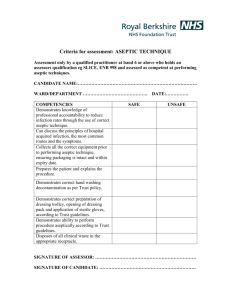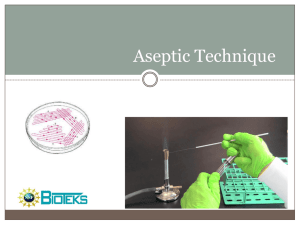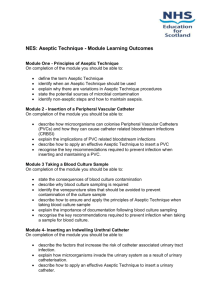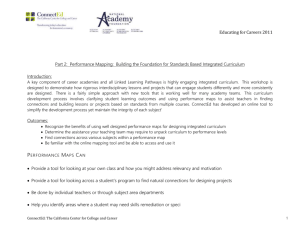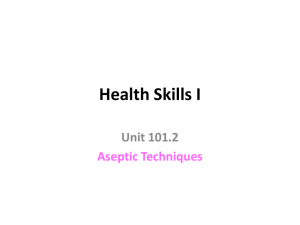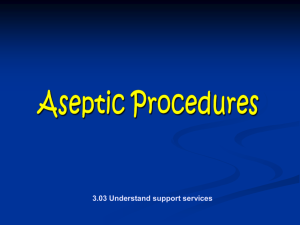aseptic technique - Infection Prevention Control
advertisement
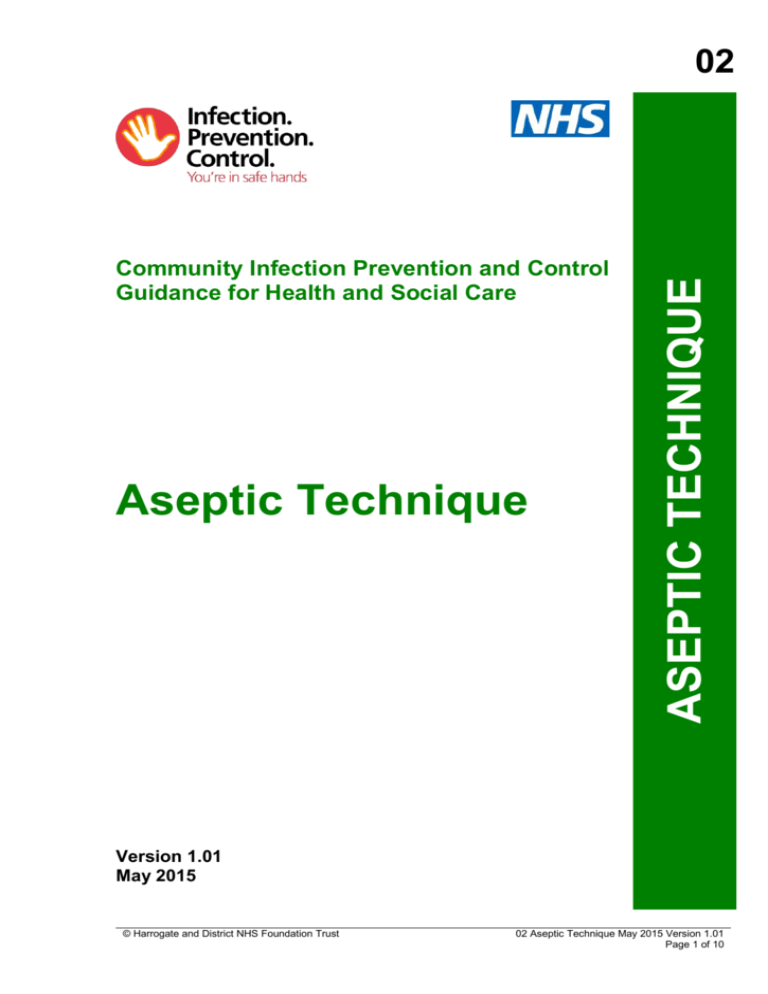
Community Infection Prevention and Control Guidance for Health and Social Care Aseptic Technique ASEPTIC TECHNIQUE 02 Version 1.01 May 2015 © Harrogate and District NHS Foundation Trust 02 Aseptic Technique May 2015 Version 1.01 Page 1 of 10 02 Please note that the internet version is the only version that is maintained. Any printed copies should, therefore, be viewed as ‘uncontrolled’ and as such, may not necessarily contain the latest updates and amendments. ____________________________________________________________________ This guidance document has been adopted as a policy document by: ASEPTIC TECHNIQUE Organisation: .................................................................................... Signed: ............................................................................................ Job Title: .......................................................................................... Date Adopted: .................................................................................. Review Date: .................................................................................... _______________________________________________________ Community Infection Prevention and Control Harrogate and District NHS Foundation Trust Gibraltar House Thurston Road Northallerton North Yorkshire DL6 2NA Tel: 01423 557340 email: ipccommunity@hdft.nhs.uk www.infectionpreventioncontrol.co.uk Legal Disclaimer This guidance produced by Harrogate and District NHS Foundation Trust is provided ‘as is’, without any representation endorsement made and without warranty of any kind whether express or implied, including but not limited to the implied warranties of satisfactory quality, fitness for a particular purpose, noninfringement, compatibility, security and accuracy. These terms and conditions shall be governed by and construed in accordance with the laws of England and Wales. Any dispute arising under these terms and conditions shall be subject to the exclusive jurisdiction of the courts of England and Wales. 02 Aseptic Technique May 2015 Version 1.01 Page 2 of 10 © Harrogate and District NHS Foundation Trust 02 Page 1. Introduction.............................................................................................. 4 2. When should an aseptic technique be used? ........................................... 4 3. Who should undertake an aseptic technique? ......................................... 4 4. The principles of asepsis/aseptic technique ............................................. 5 5. Good practice .......................................................................................... 5 6. The procedure for dressing a wound using an aseptic technique ............. 5 7. Non-touch technique (clean technique) ................................................... 7 8. Symbols and their meanings.................................................................... 9 9. Additional IPC resources ......................................................................... 9 10. References .............................................................................................. 9 11. Appendices .............................................................................................. 9 Appendix 1: Hand Hygiene Technique for Staff ........................................... 10 © Harrogate and District NHS Foundation Trust ASEPTIC TECHNIQUE Contents 02 Aseptic Technique May 2015 Version 1.01 Page 3 of 10 02 ASEPTIC TECHNIQUE 1. Introduction ASEPTIC TECHNIQUE An aseptic technique is used to carry out a procedure in a way that minimises the risk of contaminating an invasive device, e.g., urinary catheter, or a susceptible body site such as the bladder or a wound. 2. When should an aseptic technique be used? The following are some examples of when an aseptic technique should be used, but is not an exhaustive list: when inserting, maintaining or dressing an invasive device, e.g., urinary catheter, wound drain when infusing sterile fluids and medication when dressing wounds healing by primary intention, e.g., surgical wounds, burns dressing deep wounds that lead to a cavity or sinus minor surgery procedures suturing wounds vaginal examination using instruments, e.g., smear taking, high vaginal swab, insertion of IUCD if the patient is immunosuppressed, diabetic or at high risk of infection. 3. Who should undertake an aseptic technique? Only staff trained and competent in an aseptic technique should undertake this procedure. Adherence to the principles of asepsis (as described below) plays a vital role in preventing the transmission of infection in any environment. It is the responsibility of each member of staff who undertake an aseptic technique to understand the meaning of these principles and to incorporate them into their everyday practice. Education, training and assessment of aseptic technique should be provided for all persons before undertaking such procedures. It is good practice to undertake peer audits to monitor competency and a record of training and audit should be available. Staff undertaking an aseptic technique should be free from infection, e.g., colds, sore throats, septic lesions. 02 Aseptic Technique May 2015 Version 1.01 Page 4 of 10 © Harrogate and District NHS Foundation Trust 02 4. The principles of asepsis/aseptic technique Asepsis is defined as the absence of pathogenic (harmful) organisms. reducing activity in the immediate vicinity of the area in which the procedure is to be performed keeping the exposure of a susceptible site to a minimum checking all sterile packs to be used for evidence of damage or moisture penetration ensuring all fluids and materials to be used are in date not re-using single use items ensuring contaminated/non-sterile items are not placed in the sterile field ensuring appropriate hand decontamination prior to the procedure protecting uniform/clothing with a disposable apron using sterile gloves. 5. Good practice Use standard precautions. Dispose of single use items after use. Do not re-use. Dispose of single patient use items after the service user's treatment (single patient use items can be decontaminated and re-used again on the same service user, but cannot be used on another service user). Store sterile equipment in clean, dry conditions, off the floor and away from potential damage. Dispose of waste as per local policy. 6. The procedure for dressing a wound using an aseptic technique Avoid exposing or dressing wounds or performing an aseptic procedure for at least 30 minutes after bed making or domestic cleaning to allow any dust particles to settle. Staff should be ‘Bare Below the Elbows’ (see Hand Hygiene Guidance). Maintain a sterile field throughout the procedure. © Harrogate and District NHS Foundation Trust ASEPTIC TECHNIQUE The principles of asepsis/aseptic technique are: 02 Aseptic Technique May 2015 Version 1.01 Page 5 of 10 ASEPTIC TECHNIQUE 02 Decontaminate hands by washing with liquid soap and warm water or by applying alcohol handrub, using the recommended technique (see Appendix 1: Hand hygiene technique for staff poster). Decontaminate the trolley (or working surface to be used if trolley not available, e.g., in a service users home) with detergent and warm water or detergent wipes and dry. Assemble sterile procedure packs, e.g., dressing packs and equipment, check all items are in date and packaging is intact. Ensure any windows are closed and fans switched off. Explain and discuss the procedure with the service user. Ensure service user is positioned both comfortably and so the area to be exposed is accessible without undue exposure. Put on disposable apron. If an old dressing is in place, loosen the tape/adhesive securing it, but leave in place. Decontaminate hands with alcohol handrub. Open sterile procedure pack outer packaging, sliding the contents onto the top shelf of the trolley (or working surface). Open the sterile field by using the corners of the paper. Add any extra items without compromising the sterile field. Decontaminate hands with alcohol handrub. Lift the plastic waste disposal bag from the sterile field carefully by its open end and holding one edge of the opening end, place the other hand into bag, hence covering the hand with a sterile 'glove'. Using the sterile 'glove', arrange sterile items on the sterile field. With sterile 'glove' still in place, remove the old dressing from wound. Invert the 'glove', removing it from hand ensuring the old dressing is left inside it. Attach the bag to the trolley, below the top shelf or on a nearby surface if in a service user's home. Avoid exposing the wound for longer than the minimum time to prevent air borne contamination and to maintain optimal wound temperature. Apply alcohol handrub and put on sterile gloves ensuring hands do not contaminate outer surface of the glove. Perform the procedure, including cleaning of the skin where applicable. Ensure equipment is discarded if it becomes contaminated. Dispose of all used items, including soiled dressings, into the plastic waste disposal bag and seal. Discard disposal waste bag into infectious waste bag. Remove gloves and apron, discard into infectious waste bag. Decontaminate hands with alcohol handrub. 02 Aseptic Technique May 2015 Version 1.01 Page 6 of 10 © Harrogate and District NHS Foundation Trust 02 Decontaminate the working surface with detergent and warm water or detergent wipe. Decontaminate hands with liquid soap and warm water or apply alcohol handrub. Complete appropriate documentation. This is a modified aseptic technique that can be used for undertaking procedures on vulnerable sites that are not sterile, but there is a need to avoid the introduction of micro-organisms to the site. A non-touch technique (clean technique) should be used for the following: dressing open wounds that are healing by secondary intention, e.g., pressure sores, leg ulcers, dehisced wounds, dry wounds, simple grazes and removing sutures endotracheal suction removal of an indwelling urinary catheter emptying a urinary catheter drainage bag vaginal examination (in the absence of instrumentation). The aim is to avoid contamination by not touching key elements, e.g., the inside surface of a sterile dressing, end of a sterile connection or other item that will be in contact with a susceptible site. A disposable apron should be worn. Non-sterile gloves can be worn, as they are usually for the protection of staff rather than the service user. Tap water rather than sterile saline can be used for the cleaning of wounds. Please note: if wounds enter deeper sterile body areas, then an ASEPTIC TECHNIQUE must be used. If the risk assessment shows the service user to be high risk, then an aseptic technique must be used. If two procedures are being undertaken, e.g., suction and a wound dressing, change gloves and decontaminate hands between each procedure. ASEPTIC TECHNIQUE 7. Non-touch technique (clean technique) Summary for wound dressings Aseptic technique Clean technique Gloves Sterile Non-sterile Dressings Sterile Sterile Cleansing solution Sterile water/ saline/antiseptic Tap water © Harrogate and District NHS Foundation Trust 02 Aseptic Technique May 2015 Version 1.01 Page 7 of 10 02 Technique for commonly performed procedures Procedure Technique Comments Indwelling urinary catheter insertion Aseptic Wash perineum with soap/water. Clean urethral meatus with sterile normal saline. ASEPTIC TECHNIQUE Use sterile single use container, lubricant/anaesthetic gel to reduce trauma Suprapubic catheter insertion Aseptic Treat as surgical wound until healed Intermittent catheterisation Clean When a service user is performing self-catheterisation at home. Aseptic When undertaken by a health and social care worker in all settings Catheter maintenance Clean Daily routine hygiene and after bowel movement Emptying drainage bag Clean In a health care setting: swab drainage tap with alcohol wipe before and after opening. In a service users own home: wipe drainage tap with a clean tissue after emptying, to prevent drips Catheter removal Clean Clean meatus with soap and water Cervical smear Clean Use a sterile disposable (single use) speculum or a re-usable one that has been sterilised by an accredited Decontamination Services department IUD insertion Aseptic Suction: Pharyngeal Endotracheal Tracheostomy change Clean Clean Aseptic Dispose of catheter after each insertion Enteral feed: Administration Tube management Aseptic Aseptic Administration sets and feed containers are single use Aseptic Disinfect hubs/ports before and after use with 2% chlorhexidine gluconate in 70% isopropyl alcohol Central lines Administration IV medication 02 Aseptic Technique May 2015 Version 1.01 Page 8 of 10 © Harrogate and District NHS Foundation Trust 02 8. Symbols and their meanings Symbols and their meanings Use by date, i.e., use by 30 June 2015 Do not re-use, Single use, Use only once 2015-06 Date of manufacture, i.e., manufactured during June 2015 Batch code 9. Additional IPC resources The North Yorkshire and York Community Infection Prevention and Control (IPC) team have produced a wide range of innovative educational and other IPC resources, including support for aseptic technique, e.g., Hand Hygiene Technique for Staff poster. These resources are designed to assist your organisation in achieving compliance with the Health and Social Care Act 2008 and CQC requirements. Further information on these high quality evidencebased resources is available at www.infectionpreventioncontrol.co.uk 10. References Department of Health (2013) Prevention and control of infection in care homes Department of Health (2010) The Health and Social Act 2008. Code of Practice for the prevention and control of infections and related guidance Department of Health (2006) Essential steps to safe, clean care Doughty L, Lister S (Eds) (2008) The Royal Marsden Hospital Manual of Clinical Nursing Procedures 7th Edition Journal of Hospital Infection Volume 86; Supplement 1; Pages S1-S70; January 2014 ASEPTIC TECHNIQUE 2015-06-30 Loveday et al (2014) epic3: National Evidence-Based Guidelines for Preventing Healthcare-Associated Infections in NHS Hospital in England 11. Appendices Appendix 1: Hand Hygiene Technique for Staff © Harrogate and District NHS Foundation Trust 02 Aseptic Technique May 2015 Version 1.01 Page 9 of 10 02 Appendix 1: Hand Hygiene Technique for staff 02 Aseptic Technique May 2015 Version 1.01 Page 10 of 10 © Harrogate and District NHS Foundation Trust
